- News
- Reviews
- Bikes
- Components
- Bar tape & grips
- Bottom brackets
- Brake & gear cables
- Brake & STI levers
- Brake pads & spares
- Brakes
- Cassettes & freewheels
- Chains
- Chainsets & chainrings
- Derailleurs - front
- Derailleurs - rear
- Forks
- Gear levers & shifters
- Groupsets
- Handlebars & extensions
- Headsets
- Hubs
- Inner tubes
- Pedals
- Quick releases & skewers
- Saddles
- Seatposts
- Stems
- Wheels
- Tyres
- Tubeless valves
- Accessories
- Accessories - misc
- Computer mounts
- Bags
- Bar ends
- Bike bags & cases
- Bottle cages
- Bottles
- Cameras
- Car racks
- Child seats
- Computers
- Glasses
- GPS units
- Helmets
- Lights - front
- Lights - rear
- Lights - sets
- Locks
- Mirrors
- Mudguards
- Racks
- Pumps & CO2 inflators
- Puncture kits
- Reflectives
- Smart watches
- Stands and racks
- Trailers
- Clothing
- Health, fitness and nutrition
- Tools and workshop
- Miscellaneous
- Buyers Guides
- Features
- Forum
- Recommends
- Podcast
TECH NEWS
Just In: 3T Strada - the future just arrived in the road.cc bike shed
The most exciting/radical/groundbreaking/divisive/controversial new bike launched this year is the 3T Strada, a disc-equipped aero road bike built around wide tyres and a 1x drivetrain. You’ll no doubt have seen our first look and first ride video from the launch earlier this year, but we now have an actual bike to test. Here’s a first look before we hit the road.
What the 3T Strada does is bring together a lot of the technology that has pervaded the road bike industry (most of it from the mountain bike side) in the past few years, and bring its all together in one cohesive package. We're talking disc brakes, wide tyres, an aero frame and 1x11 drivetrain. Some people are talking about this being the future of road bikes, which it well may be, but rather more conservatively, it at least offers another choice if you're into your cutting-edge tech.
- 14 of the best and fastest 2018 aero road bikes — wind-cheating bikes with an extra turn of speed
3T is now being handled in the UK by Saddleback, who also look after Enve, Silca, Chris King, Rotor and other high-end brands, and they’ve just built this bike up for us to test. It’s actually one of the very first bikes they’ve built and when they asked if we’d like to be one of the first to ride it, we leapt at the chance. I was down to their HQ like a shot.
It’s a suitably high-end build, as you’d expect on a frameset that costs £3,600. There are the latest Shimano Dura-Ace R91070 Di2 brake levers combined with an XT Di2 rear mech - not a typical combination but I’ve ridden a few adventure bikes with this sort of build, but this is the first time I’ve seen it on a road bike.
Enve 5.6 wheels are shod with Continental GrandPrix 4000 28mm tyres, an aero Enve handlebar, 3T stem and seatpost and Fizik Aliante saddle complete the build. This size medium bike weighs 7.7kg (16.97 lb).
It’s likely that most people interested in the Strada will spec their own dream build, but Saddleback will also be supplying a 3T build kit costing £3,850 (on top of the price of the frameset) that comprises an SRAM Force CX1 groupset with the Quarq Prime crankset, 3T Discus C60 Team wheels and 3T parts.
But there's only one chainring?
The Strada is designed specifically for a 1x groupset, there is no way of fitting a front mech. That is, without doubt, the most divisive design element of the new bike, and it’s borne of a desire to improve the aerodynamics around the bottom bracket area.
But what does it mean for the gearing choice? This bike has an 11-40t cassette and a 48t chainring, a Wolf Components ring with narrow/wide teeth intended to increase chain retention and stop it bouncing off on bumpy roads. Let’s put some numbers down to help get our hands around the difference between this and a conventional drivetrain, using a handy gear inch calculator.
The 48t to 11-40t combination on this bike provides a high and low gear of 116.38 and 32.03in respectively. For comparison, a typical 52/36 and 11-28t setup provides a high and low gear of 126.26 and 34.43inches. So you can see you’re not missing on the smallest gears, but loosing out a little at the top-end.
That could be resolved by swapping to a bigger 50t chainring if you’re a speed merchant, and that’s an option I may take up during the review process. There’s also more scope with adjusting the gear range by changing cassettes.
3T has developed its own 9-32 cassettes in two versions, called Bailout and Overdrive, that have been developed to address some of the gaps between sprockets that can occur on such wide range cassettes.
The Bailout has 9-10-11-12-13-15-17-19-22-26-32 tooth sprockets. You’ll notice that the sprockets increase in size just one tooth at a time at the business end of the cassette with an “oh shit this is a steep hill” bailout sprocket at the other end. The Overdrive has a 9-11-12-13-15-17-19-22-25-28-32 configuration aimed at providing evenly spaced gears across the middle of the cassette with that 9-tooth sprocket for keeping the power on during big descents.
The new cassettes won’t be available until December but I’ll definitely be interested in trying them out.
Wide tyres, minimal clearance and disc brakes
That’s a lot of words already on the lack of a conventional drivetrain. The other big design decision is the frame and fork being designed around wide tyres. There’s space for 25 to 30mm tyres, but these 28mm Contis actually measure 31mm.
Yes, clearance is tight, but that’s fully intentional; this is a bike designed to maximise aerodynamics in every way, it’s not designed to be a practical bike for plugging around muddy British lanes in the winter. You can’t fit mudguards. Think of it more as a time trial bike with drop handlebars. It's all about performance, about going as fast as possible. Check out any other aero road bike or time trial bike and you'll notice they have similarly small clearances as well.
I know a lot of people are looking at the disc brakes and wide tyres and automatically assuming that means it's got versatility written all over it. It hasn't. This isn't an endurance bike. It's a race bike. and it will be raced in the professional peloton next year. Lots of eyes will be on Aqua Sport Blue when the first rollout on their new bikes.
The aero approach to the frame and fork is all about offsetting the higher drag of the bigger tyres. The downtube profile, called ArcFoil, is intended to reduce drag in a wide range of real-world wind conditions and it’s wider towards the bottom bracket to better shield the water bottle from the airflow, with two mounting positions available - the lowest is the most aerodynamic if you want to use just a single bottle.
There are disc brakes because, well they are better, and they free up the fork crown to be as low as possible to decrease the frontal surface area, while the rear stays are extremely thin to maximise seated comfort.
The disc brakes use the flat mount standard, and this bike has a 160mm front rotor and 140mm rear rotor, and there are 12mm thru-axles at both ends. All cables and hoses are internally routed, and the seat clamp is also internal, tucked away inside the top tube.
So that ladies and gentleman, is a first look at the latest test bike to arrive in the office. Stay tuned for a full review very soon - this is one bike test you won't want to miss.
And if you've not watched it already, watch Dave and Tony riding the bike up and down some mountains at the launch earlier this year in this video below:
David worked on the road.cc tech team from 2012-2020. Previously he was editor of Bikemagic.com and before that staff writer at RCUK. He's a seasoned cyclist of all disciplines, from road to mountain biking, touring to cyclo-cross, he only wishes he had time to ride them all. He's mildly competitive, though he'll never admit it, and is a frequent road racer but is too lazy to do really well. He currently resides in the Cotswolds, and you can now find him over on his own YouTube channel David Arthur - Just Ride Bikes.
Latest Comments
- AidanR 6 hours 54 min ago
Bloody hell... How are you doing now?
- ktache 7 hours 3 min ago
And I liked endura too. Got a nice long sleeve mostly merino long sleeve a little while back, in orange.
- matthewn5 7 hours 31 min ago
No, the Ebay lights have been around for several years, this Lezyne light just appeared.
- chrisonabike 7 hours 47 min ago
They shouldn't worry - the second part of the "tariff" refrain is "they can make it in US and they'll do very well".
- Mr Blackbird 8 hours 19 min ago
"At the going down of the sun, it will get in our eyes and cause us to crash into things."
- Rendel Harris 8 hours 27 min ago
Been living in the area thirty years now and Brixton Cycles (and local riders wearing their famed Rastafarian colours jersey) has been an iconic...
- chrisonabike 10 hours 32 min ago
Does the "super-loud yellow" also help alert (non-deaf / non-earbud-wearing) pedestrians? Or will it just mean dogs bark at me?
- Festus 11 hours 23 min ago
One thing that bothers me is the use of antidepressant med and driving, it never gets picked up by police. Most of these types of medicines state...
- chrisonabike 13 hours 23 min ago
Indeed - but again these are perhaps questions we should keep asking. Even if the immediate answer is "well we are where we are" or "how on earth...



































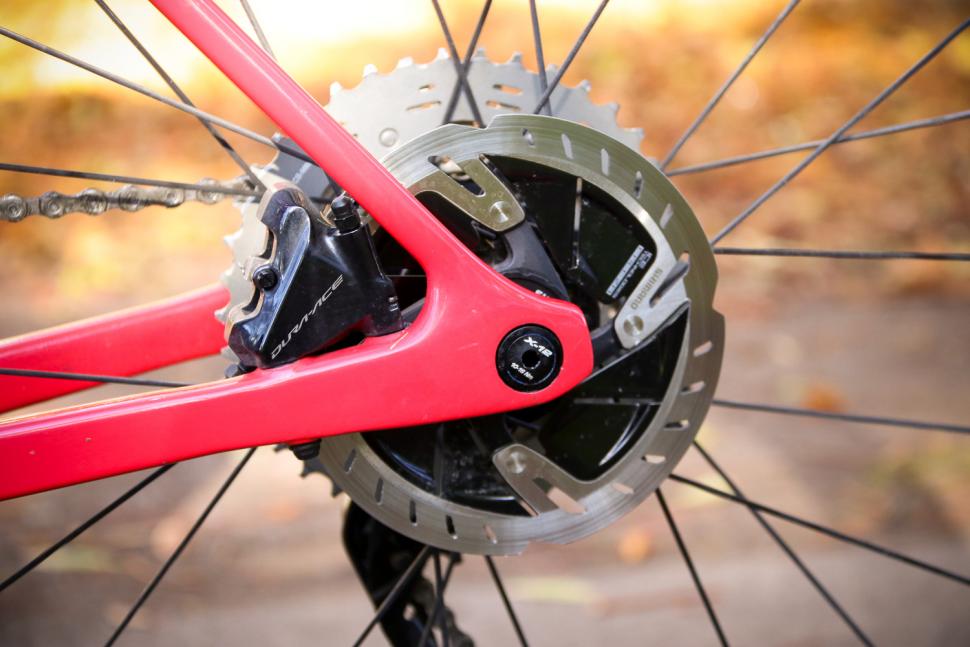

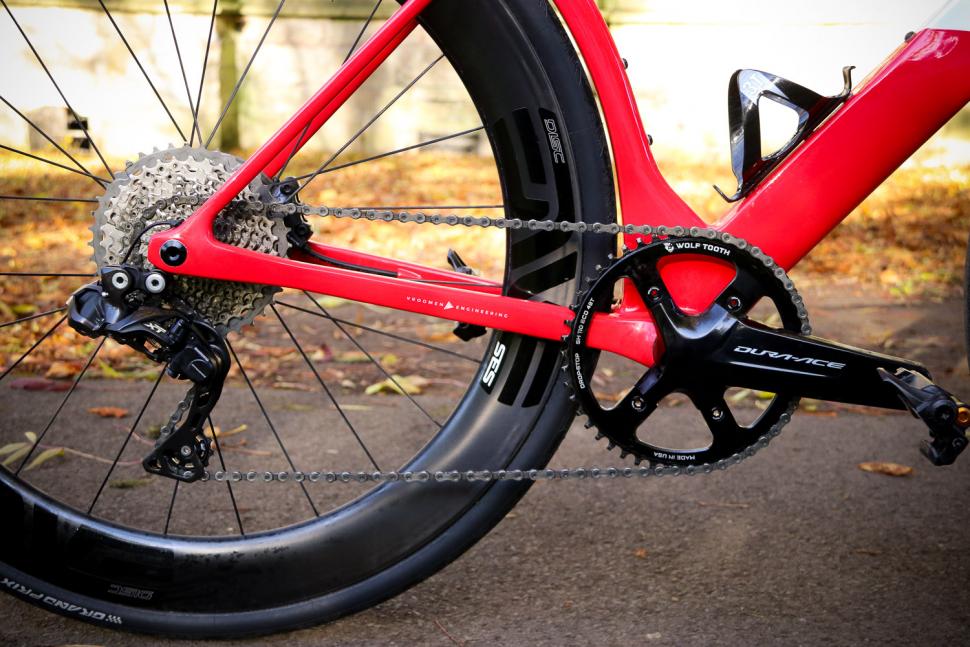

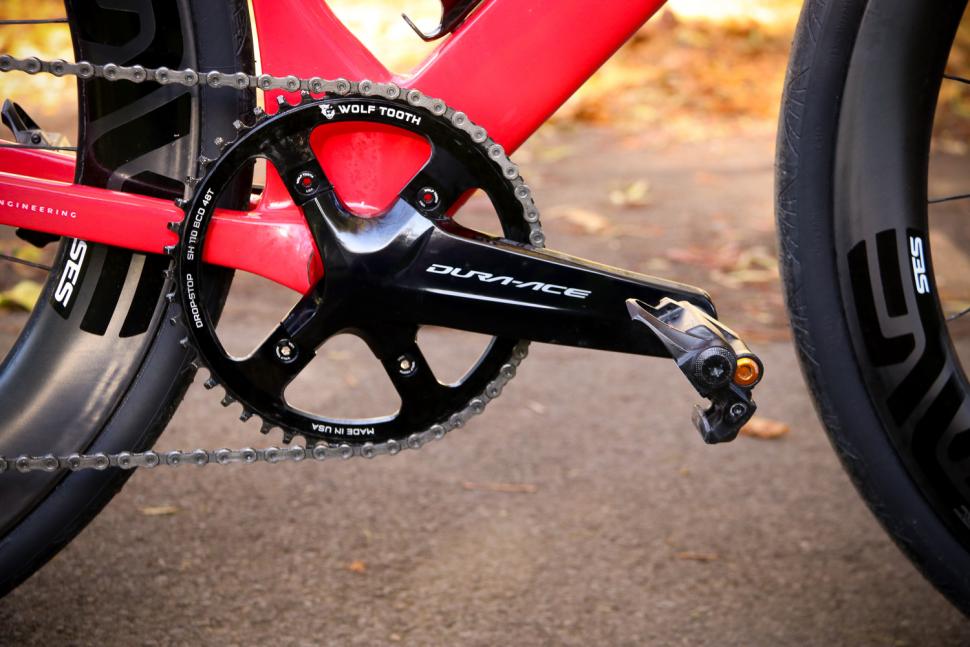

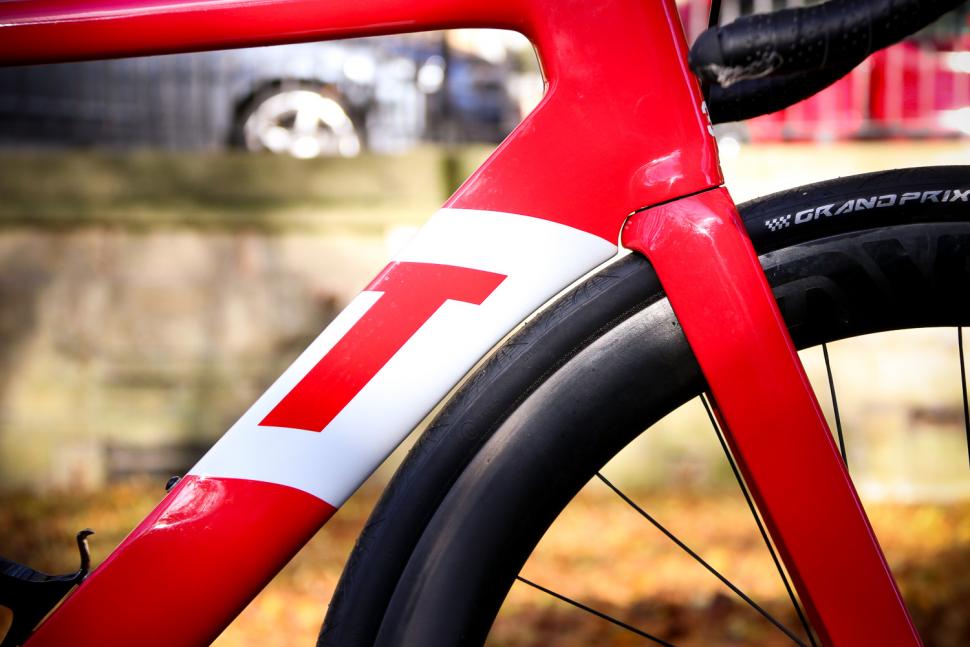
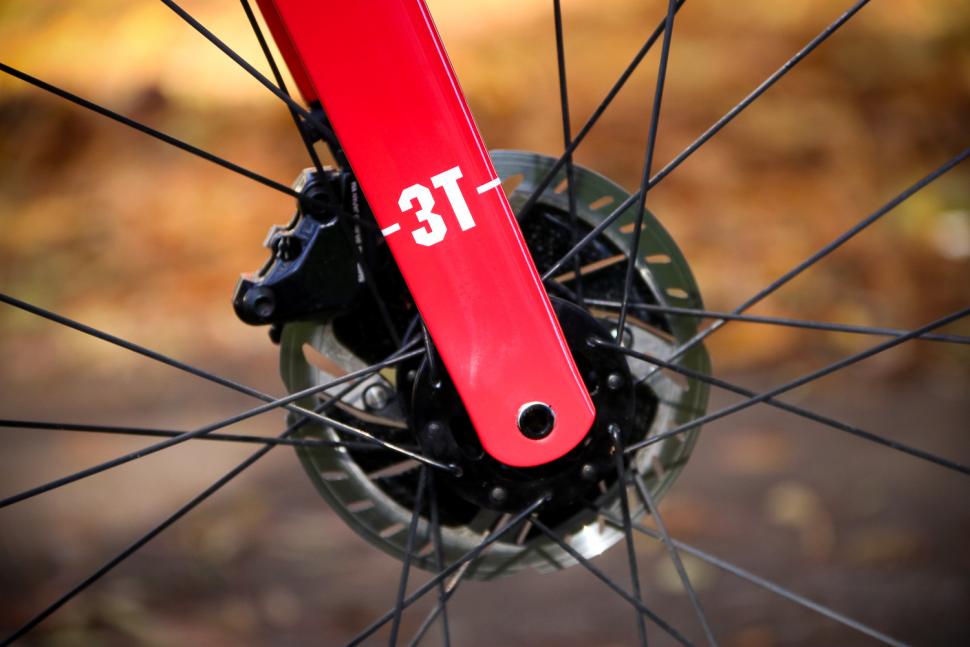
Add new comment
48 comments
Tempted by one of those Team AB framesets that Sadfleback are selling for £3900, I think it’ll be like owning a DeLorean or a Sinclair C5 in a few years
3T RIP?
Perhaps vroomen will come back and explain why Blythe is wrong and he’s still right
The reviews are in. https://www.cyclingweekly.com/news/racing/day-one-thought-not-good-idea-...
Die, 1x, die.
Quelle surprise.
I'm interested in seeing a full review of this bike. I've never ridden 1x before except in the guise of my 11 speed Alfine bike. The spread of gears on that is fine (as long as you ignore the recommended ratio of chainset to sprocket) but the steps between gears is noticeable. It's fine for commuting but you would feel it racing. Now the Alfine is more evenly stepped so perhaps the 3T cassettes will address the problem to some extent.
The tyre clearances look too small for British wet roads. The price way too steep. But it could spawn some interesting designs.
All of these queries about 1x, the hype and the suitability for British riders can be answered just as soon as we can demo one.
where can I demo one? Warwickshire here.
This thread has got proper involved. I am off to get a bag of popcorn, so I can sit back and enjoy. Great stuff. Fwiw, I think Vroomen is right (if its him).. especially about how crappy most front mechs are.
TTs are generally on newly gravel dressed roads? There's a few weeks a year where I can't avoid the things, and it gets stuck between my tyre & fork pretty often.
No, TT's are not generally on newly gravel dressed roads, but I don't know too many people who stop riding their TT/Tri bikes during those few weeks either. Anyway, by the fact that you already encounter the problem on your current bike, what's the difference? The first scratch is the deepest, then we all just go on and enjoy the ride.
Blah
As for the 3T, it's ugly, it has LESS tyre clearance than frames from a few years ago used in the cobbled classics, it's overtly spendy, did I mention it's ugly.
The 'future' would have a replaceable/flexible LCD screen that you can affix to the stem/bars for data readout and an internal data sending transmitter (instead of that fugly stickyout thing) plus a micro battery for the electronic systems that recharges on the go using 'wobble' technology or even draws energy wirelessly from detachable solar panels.
Also maybe an internal hub gear system with 14/15 gears that are operated wirelessly as we have with derailleur systems already, you get a more reliable system, robustness AND much more aero.
So have a crash and broken derailleur is not an issue, wheel changes with a wireless internal hub would be the same as now.
The aero offsets any transmission losses which are minimal when compared to the robust and touring orientated Rohloff which could be made more effficient at the expense of outright longevity which even if reduced would still be greater than the life of a derailleur system.
Other positives from an internal gear system would be the ability to have more even and higher spoke tensions giving stiffer wheels and straight chain line ALL the time.
More 'future' would be the ability to vary the tyre pressures at any given point, massive advantage on cobbled rides which you're balancing the pressures to take into account super smooth roads with sections you want relatively low pressures or when the weather changes both in temperature and precipitation.
You could even have an inetrnal ass-saver that can be deployed from the saddle and retracts when not needed.
This bike is not the future but same old shit with disc brakes that make jack shit difference except in very extreme conditions perforamnce wise and won't make riding any safer.
One last thought on future, gear shifting, gloves with the ability to shift gears by simply flicking the fingers/making a gesture like swiping a screen only without physical contact.
It's been designed as a specific road race bike - not a touring bike, not an eco-friendly/practical "ability to recharge on the go". In terms of an out and out race bike, it's not bad at all. Bit more integration with the front cables/hoses and possibly some marketing that says look, you're expected to either do it yourself or have a mechanic to do it for you but customise the bike between each ride. Hilly road race? Fit the Bailout. Crit race? Fit the Overdrive.
It's not far off what even relatively amateur CX racers will do in terms of selecting tyres/wheels by course, changing their 1x chainring to suit power course vs super muddy course. Track riders do it too, you always see people gearing up/down in between sprint and endurance sessions.
Where are you based? Let's go for a ride. You can see the 3T up close
So will you admit you're wrong and I was right, Blythe pretty much explains the problem which I said ages ago and I didn't need to ride it to know it was going to be a load of poop
As they say, people tend to overestimate short-term innovations and underestimate long-term innovations. I know companies working on most if not all of what you mention, but virtually none of it will appear in bike shops in the next three years.
And if the author calls the 3T STRADA "the most exciting/radical/groundbreaking/divisive/controversial new bike launched this year", i don't necessarily agree but the fact is that most other bikes launched must have ranked even lower on your innovation wish list. "X% stiffer in the BB, Y% stiffer in the headtube, available in disc and rim brake versions and with a D-shaped seatpost", that seemed to be the press release for most bike launches this year.
I'm intrigued and would like to try it.
Clearly there is a compromise here with either the gear range or some steps. That means the claimed gains - simplicity, cost, weight and aero have to outweigh those for it to be a sensible proposition - clearly very subjective.
Personally, I rarely push hard downhill (I'm normally resting from having done the uphill bit) and the 3T overdrive 9-32 new cassette with a 36T chain ring would cover 99% or more of my pedal strokes.
The best answer would be cassettes that are made up of single rings (or at least small sets of rings) so that you can easily build your own cassette, I bet that when it comes to chain and cassette changes only about 3 or 4 of the middle gears are actually wornenough to justify the change.
What we really need are some comprehensive tests of these bikes to test their aero credentials and actually see how much of the claims are real and how much is marketing guff purely designed to part us from our cash
I keep comming back to the same question, "who needs 1x more, us or the manufacturers and retail outfits?"
Isn't the answer in the vast majority of purchases of any kind, including virtually any bike anybody buys unless their current one just got trashed or stolen, that people don't "need" anything?
I have 1x with Bailout and Overdrive, it's called a triple...
So 3T are willing to drop the x2 for a x1 and loose the undeniable benefits of closer gear ratios for a small aero gain, but they can't be arsed to hide the cables up at the pointy end?
That was my first thought too - for that sort of price I'd expect a BMC style full integration of hoses and cables/wires with them routed down the bars and headtube. Disc hoses and Di2 don't require straight cable runs, you can bend them round all sorts of corners and they'll still be perfect.
1x makes a lot of sense for certain applications, notably crit racing. Many UK road race circuits could also comfortably be ridden on a 1x.
Love it. End of.
... And the future is fugly. As for 1x it'd make sense on a daily commuter, where I'd never need anything taller than a 46x11 or summat. But on the Sunday best, not so much.
I hit 37mph within 2 minutes of leaving home just going to Tesco 1.7 miles away and spin out on my daily on its 48/12 top gear regularly and I don't even live in a particularly hilly area.
It's the (relatively) big gaps in a 1x that are not really ideal for efficient cycling, it's okay if you want to potter around/leisurely commute and you don't need much above a 24T sprocket but cassettes with a 30T or bigger with an 11 or even 12 first position and the gaps are noticeable when you're used to the closer ratios of modern multi-speed gearing. It can upset your rythm/cadence even for commuting.
the reason i still like a triple is you can run a 11-25/26 and still have a decently low enough gear to get you up an alpine ascent even when you're very much the wrong side of 40 and 100kg but also have the big dog for when you want to hammer it. Having those much smaller gaps when transitioning gradients or if you're struggling and keeping your cadence is quite important I feel.
I used to have an old 6 speed hi-lo, there was a massive gap between the bottom three and the top three but at least the sprockets were relatively close (for the time) at each end, when using an 'alpine' set up 14/16/18/24/28/32 was actually extremely helpful/useful. Being able to fit your own sprockets onto a freewheek body to suit the terrain and your own personal requirements is something that is so much harder to do these days.
1x is not going to be much use in compeition road racing, as i said a month or two back on another thread, maybe in a flat stage or crit but for the sake of a few grams, running out of gears and/or having jumps that mean you lose rythm is simply not a good exchange IMHO.
I expected that the 1x aspect will be the most discussed on this page
Two of my road bikes are 2x, one is 1x and I firmly believe that this decision is only a matter of compromise.
On 2x side there is the range and small cadence steps, on 1x there is silent drivetrain (due to narrow/wide rings), easier maitenance (on Sram rear derailleur there is a lock that removes tension from the chain and you can jus put the chain off the chainring and clean it properly) and no chain rub.
Since I use both systems, I could live with only 1x, but there is no need.
IfI had the funds to buy this bike, I would use smaller range cassette (11/32 or smaller and several chains/chainring combos to suit different terrain.
That front clearance when you hit a stretch of newly 'dressed' road is going to ruin your day, and your frame.
Well, somehow we haven't seen thousands and thousands of TTers or triathletes with ruined frames even though the gap is the same.
Looking at the clearance between the front wheel and down tube, I hope they have made that front fork super stiff.
I can see that tyre rubbing the downtube under heavy braking, which from experience, I can assure you is a shit thing to happen.
Still unconvinced by 1x for the road. MTB yep, mud clearance, greater chainrings clearance. Cross, yep, only need a relatively small range if gears, plus mud clearance and chain ring clearance. But for the road... you need a wide range of gears for hilly terrain, and you need closely spaced gears for comfort and efficiency.
Oh and the is no need for mud clearance, or indeed chain ring clearance.
For me the solution for non professsional racers is either 3X or 1X. The 2X has all the extra parts with range not very far from 1X. I cannot understand why has it prevailed.
Pages